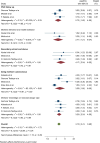Mothers' health-seeking practices and associated factors towards neonatal danger signs in Ethiopia: a systematic review and meta-analysis
- PMID: 39532356
- PMCID: PMC11574468
- DOI: 10.1136/bmjopen-2024-086729
Mothers' health-seeking practices and associated factors towards neonatal danger signs in Ethiopia: a systematic review and meta-analysis
Abstract
Background: A decrease in obtaining quality healthcare is a major cause of maternal and newborn deaths in low-income and middle-income countries. Ethiopia has one of the highest neonatal mortality rates. Increasing mothers' health-seeking practices related to neonatal danger signs is an essential strategy for reducing the death rate of newborns. However, the pooled prevalence of mothers' health-seeking practices related to neonatal danger signs is not well known in Ethiopia.
Objective: The main aim of this systematic review and meta-analysis is to assess the mothers' health-seeking practices and associated factors towards neonatal danger signs in Ethiopia.
Design: Systematic review and meta-analysis.
Primary and secondary outcomes: The primary outcome was to assess the mothers' health-seeking practices towards neonatal danger signs and the secondary outcome was to identify factors associated with health-seeking practices.
Methods: In total, comprehensive literature was searched in the PubMed, Google Scholar, HINARI, Embase and CINAHL databases published up to 30 December 2023. A random effect model was used to estimate the pooled prevalence and adjusted OR (AOR). Stata (V.17.0) was used to analyse the data. I2 statistics were computed to assess heterogeneity among studies. To minimise the underlying heterogeneity, a subgroup analysis was conducted based on the study region and year of publication. To assess publication bias, Egger's test and funnel plots were used.
Results: Overall, 1011 articles were retrieved, and 11 cross-sectional studies, with a total of 5066 study participants, were included in this systematic review. The overall pooled prevalence of mothers' health-seeking practices for neonatal danger signs in Ethiopia was 52.15%. Postnatal care follow-up (AOR 2.72; 95% CI 1.62 to 4.56), good maternal knowledge (AOR 3.20, 95% CI 2.24 to 4.56), educational status of secondary school and above (AOR 4.17, 95% CI 2.04 to 8.55), women's decision-making autonomy (AOR 3.59, 95% CI 1.60 to 8.06) and place of delivery (AOR 2.71, 95% CI 1.21 to 6.04) were significantly associated with mothers' health-seeking practices for neonatal danger signs.
Conclusion: The maternal health-seeking practices of women towards neonatal danger signs were found to be low in Ethiopia. When barriers to seeking care for newborn danger signs are successfully removed, women's practices for seeking care for neonatal danger signs could decrease perinatal mortality.
Keywords: Meta-Analysis; NEONATOLOGY; Neonatal intensive & critical care; Paediatric intensive & critical care.
© Author(s) (or their employer(s)) 2024. Re-use permitted under CC BY-NC. No commercial re-use. See rights and permissions. Published by BMJ.
Conflict of interest statement
Competing interests: None declared.
Figures



Similar articles
-
Women's knowledge towards neonatal danger signs and its associated factors in Ethiopia: a systematic review and meta-analysis.BMC Pediatr. 2020 May 14;20(1):217. doi: 10.1186/s12887-020-02098-6. BMC Pediatr. 2020. PMID: 32408874 Free PMC article.
-
Determinants of maternal knowledge on neonatal danger signs and care-seeking practices in a rural area of southeastern Ethiopia.Int Health. 2022 Nov 1;14(6):610-618. doi: 10.1093/inthealth/ihab084. Int Health. 2022. PMID: 34921316 Free PMC article.
-
Maternal Health Care Seeking Behavior for Neonatal Danger Signs and Associated Factors Among Post-Partum Mothers in Southeast Ethiopia: A Cross-Sectional Study.Inquiry. 2022 Jan-Dec;59:469580221143629. doi: 10.1177/00469580221143629. Inquiry. 2022. PMID: 36541223 Free PMC article.
-
Awareness and healthcare seeking behavior of neonatal danger signs, and predictor variables among mothers/caregivers in four developing regional state of Ethiopia.BMC Pediatr. 2024 Mar 16;24(1):188. doi: 10.1186/s12887-024-04656-8. BMC Pediatr. 2024. PMID: 38493094 Free PMC article.
-
WOMEN's Knowledge of Obstetric Danger signs in Ethiopia (WOMEN's KODE):a systematic review and meta-analysis.Syst Rev. 2019 Feb 25;8(1):63. doi: 10.1186/s13643-019-0979-7. Syst Rev. 2019. PMID: 30803443 Free PMC article.
References
-
- WHO Guidelines Approved by the Guidelines Review Committee . Pocket book of hospital care for children: guidelines for the management of common childhood illnesses. Geneva: World Health Organization; 2013. - PubMed
-
- Anmut W, Fekecha B, Demeke T. Mother’s knowledge and Practice about Neonatal Danger Signs and Associated Factors in Wolkite Town, Gurage Zone, SNNPR, Ethiopia, 2017. J Biomedical Sci . 2017;06 doi: 10.4172/2254-609X.100077. - DOI
-
- UNICEF United Nations Inter-agency Group for Child Mortality Estimation (UN IGME) Monit Situat Child Women. 2019;386:2276–86.
-
- UNICEF Levels and trends in child mortality. 2021.
Publication types
MeSH terms
LinkOut - more resources
Full Text Sources
